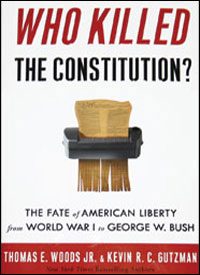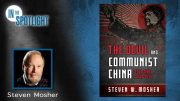
Who Killed the Constitution?: The Fate of American Liberty from World War I to George W. Bush, by Thomas E. Woods and Kevin R.C. Gutzman, New York: Random House/Crown Forum, 2008, 259 pages, hardcover.
Dr. Thomas Woods is a prolific writer who is perhaps best known for writing the first of the "Politically Incorrect Guide …" books in the popular series published by Regnery. His 2004 treatise about American history appeared on the New York Times best-seller list and its success spawned a full bookshelf of imitators issuing additional "Guides."
He has now teamed up with Western Connecticut State University American history professor Kevin Gutzman in the 259-page Who Killed the Constitution? While there is much valuable and suppressed history in the book, its title is disconcerting. The Constitution is certainly under attack, but to claim it is "killed" is an unnecessary stretch. The conclusion these two Ph.D.s have reached in their title is emphasized and repeated. Early in their book they write, "The Constitution is already dead. It died a long time ago." And they begin their concluding chapter by saying: "The Constitution is dead. That blunt but unavoidable truth should be clear by now."
Is there no hope whatsoever? The authors explain, "Thomas Jefferson … knew that if the federal government had a monopoly on constitutional interpretation, it would naturally read the Constitution in its own favor. He insisted that the states … were entitled to make constitutional determinations, because the only alternative was a central government monopoly that in the end would swallow up the states." Because they see states’ rights as dead, they maintain there is hardly a glimmer of hope that the Constitution retains some life.
However, they do actually offer a faint glimmer. In the book’s final paragraph, we read: "Nonetheless, the Constitution can still serve a purpose, as it remains a useful bludgeon to employ against government power grabs. By calling attention to what the Constitution really says, we can alert the people to just how consistently and dramatically their fundamental law has been betrayed. What they do with that knowledge is up to the American people themselves to decide." (Emphasis added.) In other words, the people can still resurrect what Woods and Gutzman claim is already a corpse.
So there is hope. If enough Americans can be made aware of how they have been bamboozled and steered away from what the Constitution really says, they can restore limited government — which means that today’s federal leviathan can still be restrained by the "chains" Jefferson saw in the venerable document. But this is possible only because the Constitution still exists, and it can still be applied as soon as an awakened American people demand it.
Although the Constitution is not dead, it is circumvented, ignored, misinterpreted, and redefined. The guts of this book, mostly a chronicling of the attacks on the Constitution rendered by the Supreme Court, make this abundantly clear. This reviewer highly recommends this important book because this history must be much more widely understood if we are to undo the damage to the venerable document.
Read here about the political maneuvering that resulted in the totally unconstitutional yet unanimous 1954 Brown v. Board of Education decision and the hard-to-believe fallout from that exercise in judicial fiat — very much including federal control of education. Yet even the Supreme Court occasionally put the brakes on the usurpation of power. Such was the case when Harry Truman audaciously claimed that his "commander in chief" designation gave him the authority to seize the nation’s steel industry during the Korean War.
Much understanding of the real Constitution is provided by citing early commentaries and even judicial rulings rendered before the attackers gathered steam. One will learn how there never should have been a military draft, a cancellation of prayer in the schools, phony war powers assumed or awarded to the executive branch, the costly earmarking procedure, intrusions into private medical practice, and presidential "signing statements."
The assault on the Constitution, as this book shows, didn’t begin in the 20th century. Whether it can be ended and reversed in the 21st century is the big question. Woods and Gutzman’s book will help anyone interested in such a development to understand how the nation got to this perilous position. Who Killed the Constitution? will help a reader to understand the problem — which, of course, is the first step in solving it.



